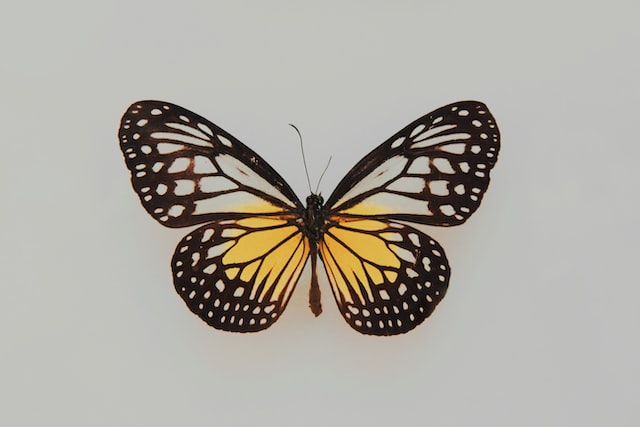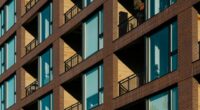Butterflies and moths have many similarities, but there are several key differences between the two that make them easily identifiable. The most obvious difference is in their appearance; butterflies tend to be brightly-colored with delicate wings and antennae, while moths are usually drabber in coloration and have thicker bodies. Butterflies also mainly feed on nectar while moths often consume pollen or other sources of nutrition.
What is a butterfly?

Butterflies and moths are both insects in the order Lepidoptera. The main difference between butterfly and moth is that butterflies are active during the day while moths are mostly active at night. Butterflies have bright colors and patterns on their wings, while most moths are brown or gray. Some people also think that butterflies fly more gracefully than moths.
Characteristics of Butterflies
Butterflies are known for their bright colors and delicate appearance, with wings that are often marked with intricate patterns and designs. They are typically active during the day and feed on nectar from flowers, using their long proboscis to extract the sweet liquid.
In addition to their distinctive appearance, butterflies are also characterized by their smooth, cylindrical bodies, with antennae that are club-shaped at the tips. When not in flight, butterflies will often rest with their wings folded vertically over their backs.
What is a moth?
(Photo by Aman Shrestha on Unsplash )

Moths are a type of insect that belongs to the order Lepidoptera, which also includes butterflies. Both moths and butterflies have four wings that are covered in scales, but there are some key differences between them. For instance, moths typically fly at night while butterflies fly during the day. Additionally, moths often have duller colors and their wings are generally wider than butterflies’ wings.
Characteristics of Moths
Moths, on the other hand, are typically active at night and are known for their drab, muted colors and furry bodies. They feed on a variety of substances, including nectar, tree sap, and even clothing made from natural fibers.
Unlike butterflies, moths have antennae that are feathery or comb-like in appearance, and they often rest with their wings spread flat, concealing their bodies. Moths are also often larger than butterflies, with many species having wingspans that measure several inches across.
The difference between butterflies and moths
There are several key differences between butterflies and moths. For one, butterflies are diurnal, meaning they are active during the day, while moths are nocturnal, meaning they are active at night. Additionally, butterflies typically have brighter colors and patterns on their wings than moths. Another key difference is that butterflies generally have a slender body with long antennae, while moths tend to have a thicker body with shorter antennae. Finally, when a butterfly rests with its wings open, it closes them when it sleeps, but a moth will keep its wings open even when resting.
- Activity level: Butterflies are typically active during the day, while moths are active at night.
- Coloration: Butterflies are known for their bright colors and intricate patterns, while moths are typically duller in color and less eye-catching.
- Body shape: Butterflies have smooth, cylindrical bodies, while moths are often stockier and more densely furred.
- Antenna shape: Butterfly antennae are club-shaped, while moth antennae are feathery or comb-like.
- Wing posture: When at rest, butterflies often hold their wings vertically over their backs, while moths spread their wings flat to conceal their bodies.
- Role of Butterflies and Moths in the Ecosystem
- Both butterflies and moths play important roles in the ecosystem, serving as pollinators, food for other animals, and as indicators of environmental health.
Butterflies, with their bright colors and attraction to flowers, are excellent pollinators and play a key role in maintaining healthy plant populations. They also serve as food for birds and other predators, helping to maintain a balanced food chain.
Moths, with their night-time activity and ability to feed on a variety of substances, also play important roles in the ecosystem. Some species of moths act as pollinators, while others serve as food for bats, spiders, and other predators.
How to identify a butterfly
When most people think of butterflies, they think of beautiful, delicate creatures fluttering around in the sunshine. However, not all butterflies are harmless little creatures – some can actually be quite harmful! So how can you tell the difference between a butterfly and a moth?
There are several physical differences between butterflies and moths that can help you to identify them. For example, butterflies tend to have thinner bodies than moths, and their wings are usually much brighter in color. In addition, if you look at a butterfly’s wings closely, you’ll notice that they have tiny scales on them, while moth wings do not.
Another way to tell the difference between these two insects is by their behavior. Butterflies are diurnal (active during the day), while moths are nocturnal (active at night). Finally, moths typically have a greater variety of wing patterns than butterflies.
Now that you know how to tell the difference between these two types of insects, you can be sure to avoid any harmful ones!
How to identify a moth
Moths and butterflies both belong to the order of insects known as Lepidoptera. While there are many similarities between the two, there are also some key differences. For instance, moths tend to be active at night while butterflies are typically active during the day. Moths also typically have thicker bodies and hairier wings than butterflies.
There are a few easy ways to tell a moth apart from a butterfly. First, take a look at the wings. Moth wings will typically be held close to the body when at rest, while butterfly wings will be open and spread out. Secondly, check for antennae. Butterfly antennae are thin and curved, while moth antennae are often thicker and more straight. Finally, look at the mouthparts. Butterfly mouthparts extend outward into a long tube, while moth mouthparts remain close to the head and are much shorter.
What are the different kinds of butterflies?
There are two main types of butterflies- those that are diurnal (active during the day) and those that are nocturnal (active at night). There are also a few types that are semi-diurnal (active during twilight hours). Diurnal butterflies are often brightly colored and have patterns on their wings that help to camouflage them from predators. Nocturnal butterflies tend to be duller in color and do not have as much camouflage. However, both types of butterflies serve the same purpose- to pollinate plants.
What are the different kinds of moths?
There are about 160,000 species of moths worldwide. They come in a variety of colors, sizes, and shapes. Some common types of moths include:
- Clothes Moths: These moths are attracted to natural fibers like wool and cotton. They can cause damage to clothing and other fabrics.
- Cockroaches: While not technically moths, these pests are often lumped in with them. Cockroaches are attracted to food and water sources and can be difficult to control.
- Earwigs: These moths have long pincers on their back legs. They feed on plants and can be a nuisance in gardens.
- Gypsy Moths: These Invasive moths are a major problem in North America. They defoliate trees and can cause serious damage to forests.
What is the lifecycle of a butterfly?
A butterfly’s life cycle consists of four stages: egg, larva, pupa, and adult. The time it takes to complete the cycle varies from species to species, but it usually takes between two and eight weeks.
During the egg stage, a female butterfly lays her eggs on a plant that her larvae will feed on once they hatch. Once the eggs hatch, the larvae (caterpillars) begin to feed voraciously, growing larger and shedding their skin multiple times as they do so.
As the caterpillars continue to grow, they eventually enter the pupal stage, during which they transform into butterflies. This transformation is complete metamorphosis, meaning that the caterpillar and butterfly are two completely different creatures. During pupation, which typically lasts around two weeks, the caterpillar spins a silk cocoon around itself in order to protect its fragile new form.
Once pupation is complete and the butterfly has emerged from its cocoon, it begins its relatively short adult life. Adult butterflies typically live for just a few weeks or months, during which time they mate and lay eggs so that the cycle can start anew.
What is the lifecycle of a moth?
The life cycle of a moth is similar to that of a butterfly, but there are some key differences. For example, moths generally have a shorter lifespan than butterflies. Additionally, moths typically lay their eggs on the underside of leaves, whereas butterflies will lay their eggs on the top side of leaves.
When it comes to the larval stage, caterpillars of both butterflies and moths will go through a process of molting, or shedding their skin. However, caterpillars of different species can vary greatly in appearance. For instance, some caterpillars are green and blend in with the leaves they are eating, while others are brightly colored and more easily spotted by predators.
As for pupation, this is when the caterpillar spins a cocoon around itself and metamorphoses into an adult moth or butterfly. The time it takes for pupation to occur can also differ between species; some moths will pupate within two weeks, while others may take several months.
What are the benefits of a butterfly to echo system?
Butterflies play an important role in ecosystems as pollinators, helping to fertilize plants and maintain biodiversity. They are also a food source for other animals, and their presence can indicate the health of an ecosystem. Additionally, the beauty and cultural significance of butterflies make them important to many communities, adding to their ecological and economic value.
What are the benefits of a moth to the eco system?
Moths, like butterflies, play a vital role in ecosystems as pollinators, helping to fertilize plants and maintain biodiversity. Moths are also an important food source for other animals, such as bats and birds, and their presence can indicate the health of an ecosystem. In addition, moths play a critical role in seed dispersal and the maintenance of natural habitats. The caterpillar stage of many species of moths is also an important source of food for other species, and some species of moths are important indicators of environmental changes, as their populations are sensitive to changes in air and water quality.








